The COVID-19 coronavirus pandemic has forced healthcare providers to make unprecedented adjustments to patient care, including the pivot to telehealth. At a series of virtual events from October 2020–March 2021, ONS members shared their challenges, successes, and future needs to permanently adopt virtual cancer care visits.
“I’ve never experienced such urgency and constant change in my career,” one participant said. Many agreed that oncology telehealth was virtually nonexistent prepandemic, but the volume exploded during the U.S.-wide quarantine in March 2020. One nurse shared that her practice went from six telemedicine visits per month prepandemic to 2,500 per month during the height of the crisis.
To better understand how nurses adapted to telehealth and develop best practices, ONS hosted 11 live virtual programs with ONS chapters, 2 Facebook Live events, a webinar, and a podcast.
Although participants agreed that the transition was rapid, unexpected, and stressful, some emphasized that most nurses have been using telehealth for many years—but simply didn’t call it telehealth. Examples included phone visits for consultations, follow-up calls, and video checks of patients’ skin to assess radiation treatment reactions.
“This wasn’t totally new. You have the skills. You are capable,” one participant said.
Technology Can Be Challenging—and Requires More Effort for Human Connection
The two biggest barriers nurses faced were technological difficulty and a loss of human connection.
“We’ve had to learn how to assess our patients in a different way,” one participant explained. “Learning how to assess them remotely, whether with telephone or video visits, has made us think differently.”
Nurses found it more difficult to provide emotional support and to assess certain patient factors virtually, such as dexterity, distress, reflexes, and heart and lung sounds.
And technology itself was one of the biggest barriers. As one participant said, “Nurses turned into IT.” Patients often lacked the proper equipment, software, and skills, and healthcare facilities lacked adequate equipment. Participants said they scrambled to obtain laptops, cameras, microphones, and headsets to properly equip their workstations, exam rooms, and home offices.
Time for preappointment work to ensure that all parties were confirmed and ready to participate was also a factor. Participants said that much of their time involved preappointment planning to ensure that patients had the tools they needed to join a teleoncology appointment, their phones would not block healthcare providers’ calls, they were correctly identified before the visit, and conversations were adequately private. Telehealth required nurses to develop new procedures, workflows, and tip sheets based on trial and error.
Spotty Internet connectivity interfered with virtual visits, and sometimes sessions ran long and expired, cutting off important conversations. Some participants reported that they had to remind patients to not take telehealth appointments while doing other tasks, such as driving.
Certain populations required additional considerations, such as patients with vision or hearing impairments or those who needed interpreters.
Now, Telehealth Is the Norm
Despite the challenges, nurses agreed that telehealth is here to stay because of its many benefits, including:
- Decreased wait times for appointments
- Increased transmission protection for everyone, especially immunocompromised patients
- Easier inclusion of referring physicians, the interprofessional care team, and families
- Infrastructure to keep a practice running when a physician is out of the office
- Convenience and flexibility to better fit patients’ schedules
- Reduced travel time and costs
- More convenient and comfortable option for patients with cancer, other illnesses, or disabilities
- Fewer canceled appointments because of illness, weather, transportation, or other surprises
- Ability to give patients second opinions without the barrier of travel
Nurses Need Support to Grow the Future of Telehealth
As practices permanently adopt telehealth, nurses highlighted several opportunities for national and institutional support.
Legislators, legal teams, and payers must clarify which providers can practice which telehealth services, specifically in which locations and situations—and whether they can be paid for those services. For example, an advanced practice nurse in one state might not be legally permitted to provide telehealth care to a patient living just over the state line. Participants also experienced billing discrepancies, such as the same consultation being billable by video but not phone.
Nurses suggested developing virtual medicine kits to help patients submit their own medical data (e.g., otoscope equipped with video, stethoscope hooked up to a microphone, tongue depressor). Similarly, personal devices such as smart watches could be used more widely to track health data, such as heart rate and rhythm and oxygen saturation.
As telehealth evolves, participants said they will develop and share best practices, such as ideal schedules for preappointment work and block schedule templates for hybrid in-person and virtual visits.







